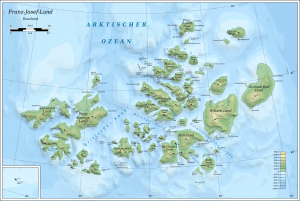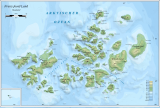Rudolf Island
| Rudolf Island | ||
|---|---|---|
| Map of the Franz Josef Land | ||
| Waters | Arctic Ocean | |
| Archipelago | Franz Josef Land | |
| Geographical location | 81 ° 46 ′ N , 58 ° 56 ′ E | |
|
|
||
| length | 25.4 km | |
| width | 15.1 km | |
| surface | 297 km² | |
| Highest elevation | 461 m | |
| Residents | uninhabited | |
| Location of Rudolf Island | ||
The Rudolf Island ( Russian остров Рудольфа , Ostrow Rudolfa) is the northernmost island of the Franz Josef Land and with 297 km² and rank 16 one of the larger islands of the archipelago. It was discovered during the Austro-Hungarian North Pole Expedition (1872–1874) and originally named after Crown Prince Rudolf of Austria-Hungary by Julius Payer, Crown Prince Rudolph Land . On the island is Cape Fligely, the northernmost land point of Eurasia.
The island was the starting point for pole expeditions at the end of the 19th and beginning of the 20th century (Teplitz Bay). The Russian polar explorer Georgi Jakowlewitsch Sedov died in 1914 near Rudolf Island and was buried on it.
Cape Fligely
The tip of the cape protruding from the surrounding ice cap of Rudolf Island into the polar sea represents the northernmost point of land in Eurasia.
Polar station
In the summer of 1932, as part of the Second International Polar Year, a weather station was set up in the west of the island on Cape Stolbowoi north of Teplitz Bay. Four people under NF Balabin spent the winter there. After a temporary closure, the station was again in operation from summer 1936 to 1995 (with a war-related interruption from April 1942 to 1947). In 1937 the station served as the base for the North Pole expedition under Papanin . As part of this, landing runways for the Tupolev ANT 6 aircraft used by the expedition were set up near the station and on the ice dome .
literature
- Judith Schalansky : Atlas of the remote islands . Fifty islands that I have never been and will never be , Mare, Hamburg 2009, ISBN 978-3-86648-117-6 .
- EI Alexandrov: Climatic regime and its changes in the region of the Barents and Kara seas (PDF; 463 kB), Russian Federation Arctic and Antarctic Research Institute, 2000, u. a. Weather data diagrams for Rudolf Island
- List of Russian Arctic Stations , Russian Federation the Arctic and Antarctic Research Institute (Russian)













